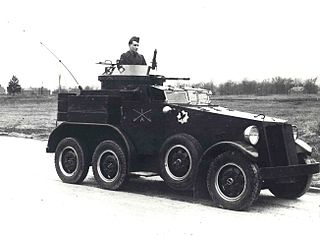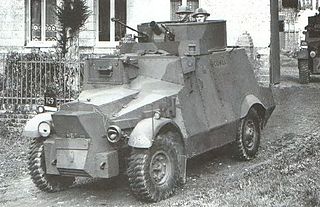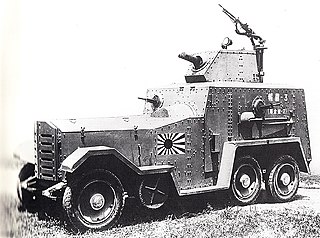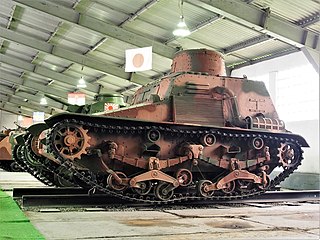 W
WThe AAC-1937, which means Autoametralladora-cañón Chevrolet modelo 1937, also known as Chevrolet 1937, was an armored car developed and built by loyalist forces during the Spanish Civil War in Catalonia. After the dismantling of the War Industry Commission of Catalonia, the Subsecretary of Weapons and Ammunitions of Spain contracted Soviet engineers to build a new armored vehicle. They took the BA-6 as a basis for the new vehicle, and built a very similar vehicle, the AAC-1937 in the Hispano-Suiza factory in Barcelona, using a chassis from General Motors Peninsular.
 W
WThe Steyr ADGZ was an Austrian-German heavy armored car used during World War II. It was originally designed for the Austrian Army from 1934, and delivered in 1935–1937.
 W
WArsenal Crossley was an Estonian armored car that was operated between 1926 and 1940. At the time it was introduced the Arsenal Crossley was one of the most modern armored vehicles in the Estonian Army. The vehicle's name is the combination of the two factories that contributed to its production. The car was manufactured in Estonia's Arsenal factory, while the engine was provided by the British company Crossley Motors Ltd and the armored plates were ordered from Sweden.
 W
WThe BA-3 was a heavy armored car developed in the Soviet Union in 1933, followed by a slightly changed model BA-6 in 1936. Both were based mostly on BA-I, the most important development being the new turret, same as in the T-26 m 1933 and BT-5 tanks, and also equipped with the 45 mm main gun. 221
 W
WThe BA-10 was an armored car developed in the Soviet Union in 1938 and produced through 1941. It was the most produced Soviet pre-1941 heavy armored car – 3311 were built in three versions. These versions were the BA-10, the BA-10M, and the BA-10ZhD. The basic BA-10 design was developed from the BA-3 and BA-6 heavy armored cars. It had an improved GAZ-AAA chassis and improved armor. It was intended that the BA-10 would be replaced in 1941 by the BA-11 with diesel engine and more sophisticated armor design, but the outbreak of war prevented BA-11 production. The BA-10 was in Red Army service until 1945. Significant numbers of captured BA-10s were used by Finland, Germany and other Axis powers in Europe.
 W
WThe BA-20 was an armored car developed in the Soviet Union in 1934. It was intended to replace the FAI and its field trials were completed in 1935. The BA-20 was then used in the early stages of World War II.
 W
WThe BA-21 was an experimental Soviet armored car from 1938. It was a major modification of the BA-20, using a triaxial truck chassis instead of biaxial. The next year, the design was further developed into the LB-23, which had a better engine. Both vehicles were not accepted for production.
 W
WThe BA-I is a Soviet three-axle armoured car. Only 82 vehicles of this type were built in 1932-1934, nevertheless the design initiated a series of heavy armoured cars of Izhorskij plant: BA-3, BA-6, BA-9, and BA-10. Some vehicles were used in World War II, despite being obsolete at the time.
 W
WThe Chiyoda armoured car was the first domestic Japanese armoured car which was officially introduced by the Imperial Japanese Army (IJA) and produced in the 1930s.
 W
WD-8 (Dyrenkov-8) was an early Soviet armored vehicle built in 1932–34. Only 60 were built; it was quickly superseded by the FAI armoured car. Both were assembled in the Izhorsky Factory near Leningrad.
 W
WThe FAI (Ford-A Izhorskiy) armoured car was a replacement for the D-8 armoured car, used by the Soviet Union from the early 1930s to early 1940s.
 W
WThe Ford FT B was the first armoured car designed and built in Poland. Built on the chassis of the Ford T and armoured with re-used armoured plates, the car was a successful design for its time. The main designer was the engineer Tadeusz Tański. The armoured vehicle originated on account of the high demand during the Polish-Soviet war in 1920.
 W
WThe Gendron-Somua AMR 39 was a prototype French armoured car.
 W
WThe Lanchester 6x4 armoured car was a British armoured car with a 6x4 drivetrain produced in limited numbers in the late 1920s and early 1930s. A heavier, more rugged development of the earlier Lanchester 4x2 armoured car, it remained in service with Territorial and colonial units until the early 1940s and saw action in the Battle of Malaya.
 W
WThe Lancia 1Z and the Lancia 1ZM were two variations of an Italian armoured car built during World War I and which saw limited service during that war, the interwar period, and during World War II. The name is often misspelled as Lancia IZM.
 W
WThe Landsverk L-185 was Swedish armored car, developed by AB Landsverk in 1933. The L-185 wasn't used by the Swedish Army. In 1934, a modified L-185, built on a 4 x 4 Fordson chassis, was sold to Denmark, being 2.5 tons heavier than the original and it was issued to the Army Technical Corps of the Danish Army, under the Danish designation FP-6. Following an engine failure in the 1937, the L-185 was relegated to the training role in 1939.
 W
WThe Landsverk L-180, L-181 and L-182 are a family of armored cars developed by the Swedish company AB Landsverk during the interwar years. They had a good international reputation for being fast, robust and reliable and were acquired in small numbers by Denmark, Estonia, Ireland and the Netherlands, among others.
 W
WThe Leichter Panzerspähwagen was a series of light four-wheel drive armoured cars produced by Nazi Germany from 1935 to 1944.
 W
WThe M1 Armored Car was a four-wheel drive American armored car tested by the United States Army Ordnance Department in 1931 and briefly in 1932. It was built by James Cunningham, Son and Company of Rochester, New York, and during testing demarcated as the Model T4.
 W
WThe Morris CS9/Light Armoured Car was a British armoured car used by the British Army in the Second World War.
 W
WThe OA vz. 27 was a Czechoslovak-designed armored car used by Nazi Germany, Slovakia, and Romania during World War II. Fifteen were built, of which the Germans seized nine when they occupied Bohemia-Moravia in March 1939 and the Slovaks captured three when they declared independence from Czechoslovakia at the same time. Romania acquired three when Czech troops sought refuge in Romania after the Hungarian invasion of Carpatho-Ukraine that same month. All were used for training or internal security duties during the war.
 W
WThe OA vz. 30 was a Czechoslovak-designed armored car used by Nazi Germany, Slovakia, Romania and Hungary during World War II. Fifty-one were built, of which the Germans seized twenty-four when they occupied Bohemia-Moravia in March 1939 and the Slovaks captured eighteen when they declared independence from Czechoslovakia at the same time. Romania acquired nine when Czech troops sought refuge in Romania after the Hungarian invasion of Carpatho-Ukraine that same month. Slovak vehicles saw combat in the Slovak-Hungarian War, the invasion of Poland, the opening months of Operation Barbarossa and the Slovak National Uprising.
 W
WThe Panhard 178 or "Pan-Pan" was an advanced French reconnaissance 4x4 armoured car that was designed for the French Army Cavalry units before World War II. It had a crew of four and was equipped with an effective 25 mm main armament and a 7.5 mm coaxial machine gun.
 W
WThe term Schwerer Panzerspähwagen, covers the six- and eight-wheeled armoured cars Germany used during the Second World War.
 W
WSamochód pancerny wz. 28 was a Polish armoured car of the 1920s. Based on French-built Citroën-Kegresse B2 10CV half-track chassis, the vehicle became the standard armoured car of the Polish Army. However, due to low speed and problems with reliability, already in 1933 it was decided to return the completed wz. 28 armoured cars to the factory and rebuild them as all-wheel Samochód pancerny wz. 34.
 W
WSamochód Pancerny wzór 29, commonly known as Ursus or CWS, was a Polish interwar heavy armored car. A handful of these vehicles saw combat during the Polish-German War of 1939.
 W
WSamochód pancerny wz. 34, was a standard light armored car used by the Polish Army during the September Campaign of 1939.
 W
WSd.Kfz. 247 schwerer geländegängiger gepanzerter Personenkraftwagen. was an armored car used by the German armed forces during World War II.
 W
WThe Sumida M.2593 was an armoured car produced by the Empire of Japan in the 1930s. It could operate on both the roadway and railway lines.
 W
WThe T7 Armored Car was a prototype small armored car produced by Holabird Quartermaster Depot for the US Army in 1930. All six vehicles that were completed, USA W1310, USA W1311, USA W1312, USA W1313, USA W1314 and USA W1315, were 4x6 wheeled vehicles, powered by Franklin's air-cooled, 6-cylinder, gasoline engine, with a crew of four and armed with one .50 calibre machine gun supported by two .30 calibre lighter machine guns.
 W
WThe Type 93 Armoured Car (九三式装甲自動車) was an armoured car used by the Empire of Japan both before and during World War II.
 W
WThe Type 95 So-Ki was an armored railroad car of the Imperial Japanese Army. It was used for patrolling and guarding railway lines in both Manchuria and Burma. The chassis was based on the Type 95 Ha-Go light tank. The Type 95 So-Ki had light armor and no fixed weapons armament. Hand-held weapons by the crew would be the only armament available. It had a simple suspension system with bogie wheels suspended on bell cranks on each side of the chassis. The tracks were driven through the front sprockets. There were three small return wheels.
 W
WThe Vickers Crossley Armoured Car a/k/a the Model 25 Vickers Crossley armoured car, was a British-made military vehicle used by the British Army in India and exported to different countries, including Japan.
 W
WThe White AM armoured car was a French First World War armoured car that was built on a commercial American White Motor Company truck chassis with armoured bodies supplied by the French firm Ségur & Lorfeuvre, it was used by the French military from its introduction in 1915. Between the wars the French military completely rebuilt the vehicles as the White-Laffly AMD 50 and the White-Laffly AMD 80, in these guises it served until at least 1943.